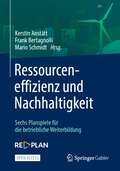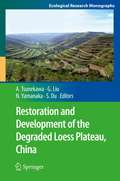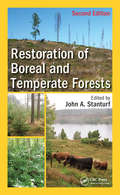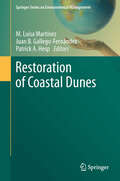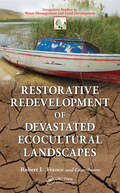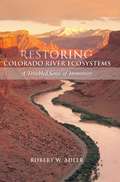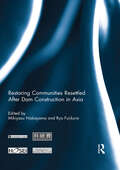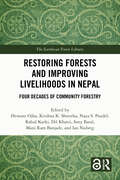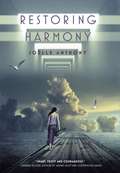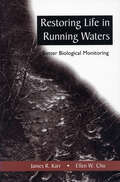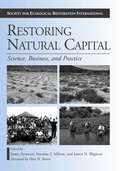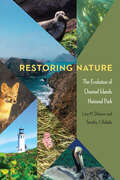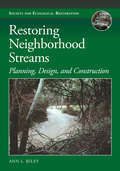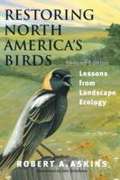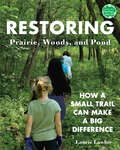- Table View
- List View
Ressourceneffizienz und Nachhaltigkeit: Sechs Planspiele für die betriebliche Weiterbildung
by Frank Bertagnolli Mario Schmidt Kerstin AnstättKlimaschutz und Ressourceneffizienz gehen häufig Hand in Hand. Mit Spiel und Spaß ressourceneffizientes Handeln fördern – das ist die Devise der Planspiele rund um das Thema Energie- und Materialeffizienz, die in diesem Buch vorgestellt werden. Die Planspiele schließen eine Lücke im betrieblichen Weiterbildungsangebot und bilden ein niederschwelliges Angebot, mit dem ressourceneffizientes Denken und Handeln spielerisch in Unternehmen eingeführt werden kann. Unternehmen aller Art können gleich auf mehrere Arten von den in den Spielen vermittelten Kenntnissen und Methoden profitieren: Durch Ressourceneffizienz-Maßnahmen werden sowohl deutliche Kosteneinsparungen erzielt als auch ein Beitrag zum Klimaschutz durch die Minderung von Treibhausgasemissionen geleistet. Dies wirkt sich nicht zuletzt positiv auf die Wettbewerbs- und die Innovationsfähigkeit aus. Darüber hinaus werden die Mitarbeiter intern mit einem attraktiven und kurzweiligen Schulungsangebot weiterqualifiziert. Die Interaktion im Spiel involviert die Mitarbeiter aktiv und motiviert sie, ihr Wissen produktiv einzubringen. Das Ergebnis sind neue Ideen für noch mehr Effizienz im Unternehmen und gleichzeitig für mehr Klimaschutz. In diesem Open Access-Buch werden sowohl das fachliche Hintergrundwissen für die in den Spielen vermittelten Methoden beschrieben als auch konkrete Anleitungen zur Durchführung der Spiele gegeben.
Restoration and Development of the Degraded Loess Plateau, China
by Norikazu Yamanaka Sheng Du Atsushi Tsunekawa Guobin LiuThis book presents state-of-the-art scientific evidence and technological innovations to restore lands on the Loess Plateau of China, known worldwide for its serious land degradation and desertification problems. Supported by a rapidly developing Chinese economy and the dissemination of effective technology, the Grain-for-Green Project and Western Development Action launched by the Chinese government have resulted in successful ecological restoration and protection over the past 30 years. These programs have contributed not only to conservation of soil and water, but also to economic development. At the same time, however, these developmental interventions have brought new challenges that have not yet been fully addressed. The book describes (1) case studies of success and failure in practice, including rare success stories of combating desertification; (2) technical issues such as erosion control and breeding of stress-tolerant plant species, and socioeconomic measures taken by the Chinese government and lending policies with support from the World Bank; and (3) comprehensive measures against desertification, such as water and wind erosion, salinization, and deforestation. This volume is recommended for researchers and students above the undergraduate level in diverse fields including soil science, rural engineering, social technology and civil engineering, biology, ecology, climatology, physical and human geography, and developmental economics, among others. It also serves as a valuable resource for engineers, government officials, and NPOs and NGOs involved in afforestation, ecological restoration, combating desertification, disaster prevention, and sustainable rural development.
Restoration and Reclamation of Boreal Ecosystems
by Dale H. Vitt Jagtar S. BhattiBoreal ecosystems contain one-third of the world's forests and stored carbon, but these regions are under increasing threat from both natural and anthropogenic disturbances. Written by leaders from the forefront of private, public and academic sectors, Restoration and Reclamation of Boreal Ecosystems emphasises a broad, conceptual approach to the specific application of empirical research into development planning, restoration and modelling of these ecosystems. The importance of this is highlighted at a time of global climate change, as these ecosystems act as carbon sinks. There is a focus on the reclamation of exploited ecosystems from a holistic standpoint, ranging from environmental and edaphic variables to the restoration of keystone flora. Recent advances in quantification of ecosystem services, such as habitat suitability and carbon storage modelling, are also detailed. The book contains case-studies which address how both historical and novel assemblages can provide ecosystem stability under projected climatic and land-use scenarios.
Restoration of Boreal and Temperate Forests (Integrative Studies in Water Management & Land Development)
by John A. StanturfThis substantially updated new edition reflects the growing recognition that large areas of forests are degraded globally. This edition describes forest restoration in the context of rapid social, economic, environmental, and climate change. Covering the last decade's significant advances in forest restoration concepts and practice, this edition has 16 new chapters and 19 thoroughly revised chapters. This book is an excellent source of information for researchers, managers, policymakers, and graduate students in forestry and ecology.
Restoration of Coastal Dunes
by Luisa M Martínez Juan B. Gallego-Fernández Patrick A. HespThe continuously growing human population along the world's coasts will exacerbate the impact of human activities on all coastal environments. Restoration activities will therefore become increasingly important. In particular, sandy shores and coastal dunes will require significant restoration efforts because they are preferred sites for human settlement, industrial and urban development and tourism. With this book experts in the field present a comprehensive review of restoration studies and activities, where 'successful' and 'failed' studies or approaches from around the world are contrasted and compared. A major asset the book provides is a compendium of studies showing that coastal dune restoration has many definitions and thus leads to many different actions. This volume addresses those with an interest in conservation ecology and biology, coastal dune dynamics and geomorphology, and coastal management who are seeking information on the different strategies for coastal dune restoration applied in different regions of the world. Finally, it will be a valuable resource for coastal scientists and planners, as well as for local and state officials, residents of coastal communities, environmental advocates and developers.
Restorative Redevelopment of Devastated Ecocultural Landscapes (Integrative Studies in Water Management & Land Development)
by Robert L. FranceA fusion of ecological restoration and sustainable development, restorative redevelopment represents an emerging paradigm for remediating landscapes. Rather than merely fixing the broken bits and pieces of nature, restorative development advocates the reuse of devastated landscapes to improve the value and livability of a location for humans at the
Restoring America's Rivers: The Movement for Dam Deconstructions and Rehabilitations
by Richard M. RobinsonThe undamming and restoration of rivers is a major component of our broader environmental movement. There are ecological, economic, and social justice issues enveloped by initiatives involving river restorations, and it’s time to focus our attention on these concerns. In this book, Richard M. Robinson reviews the removal of big concrete, big earthen, and low-head dams along North America’s larger and smaller rivers. Chapters highlight issues and contradictions related to dam safety, dam removals, and river restoration. The resulting book provides key insights into the economics and ecology of environmental restoration, our water resource management, and environmental justice.
Restoring Colorado River Ecosystems: A Troubled Sense of Immensity
by Robert W. AdlerOver the past century, humans have molded the Colorado River to serve their own needs, resulting in significant impacts to the river and its ecosystems. Today, many scientists, public officials, and citizens hope to restore some of the lost resources in portions of the river and its surrounding lands. Environmental restoration on the scale of the Colorado River basin is immensely challenging; in addition to an almost overwhelming array of technical difficulties, it is fraught with perplexing questions about the appropriate goals of restoration and the extent to which environmental restoration must be balanced against environmental changes designed to promote and sustain human economic development. Restoring Colorado River Ecosystems explores the many questions and challenges surrounding the issue of large-scale restoration of the Colorado River basin, and of large-scale restoration in general. Robert W. Adler evaluates the relationships among the laws, policies, and institutions governing use and management of the Colorado River for human benefit and those designed to protect and restore the river and its environment. He examines and critiques the often challenging interactions among law, science, economics, and politics within which restoration efforts must operate. Ultimately, he suggests that a broad concept of "restoration" is needed to navigate those uncertain waters, and to strike an appropriate balance between human and environmental needs. While the book is primarily about restoration of Colorado River ecosystems, it is also about uncertainty, conflict, competing values, and the nature, pace, and implications of environmental change. It is about our place in the natural environment, and whether there are limits to that presence we ought to respect. And it is about our responsibility to the ecosystems we live in and use.
Restoring Communities Resettled After Dam Construction in Asia (Routledge Special Issues on Water Policy and Governance)
by Mikiyasu Nakayama and Ryo FujikuraThe rapid economic expansion and population growth of developing countries in Asia has led to increasing demands for water and energy. To meet these demands, large dam development projects have been completed, which has inevitably caused involuntary resettlement. In order to support these projects, dam developers must find appropriate ways to ensure adequate livelihood reconstruction for resettled individuals. Resettlement causes both short-term and long-term effects (both positive and negative) for the relocated populations, meaning that in order to evaluate the larger impact of such projects long-term post-project evaluations must be carried out. However, post-project evaluations by international donors have typically been conducted within a few years after completion; the long-term impact of such projects is seldom evaluated.This book aims to fill this gap. A study team composed of researchers from Indonesia, Japan, Lao PDR, Sri Lanka, and Turkey has conducted ten case studies focusing on resettled individuals satisfaction, opportunities offered, and income generation. The volume provides an overview of the ten case studies, which were carried out across five countries. It also discusses how a compensation programme should be designed and what sort of options should be presented to resettled individuals for their maximum benefit.This book was originally published as a special issue of the International Journal of Water Resources Development.
Restoring Disturbed Landscapes
by John Ludwig David J. TongwayRestoring Disturbed Landscapes is a hands-on guide for individuals and groups seeking to improve the functional capacity of landscapes. The book presents a five-step, adaptive procedure for restoring landscapes that is supported by proven principles and concepts of ecological science. Abundantly illustrated with photos and figures that clearly explain concepts outlined in the book, Restoring Disturbed Landscapes is an engaging and accessible work designed specifically for restoration practitioners with limited training or experience in the field. It tells restorationists where to start, what information they need to acquire, and how to apply this information to their specific situations.
Restoring Eden: Unearthing the Agribusiness Secret That Poisoned My Farming Community
by Elizabeth D. HilbornAll spring, Dr. Elizabeth Hilborn watched as her family fruit farm of many years became increasingly diminished, suffering from a lack of bees. The plentiful wildlife, so abundant just weeks before, was gone. Everything was still, silent. As an environmental scientist trained to investigate disease outbreaks, she rose to the challenge. Step by step, day by day, despite facing headwinds from skeptical neighbors, environmental experts, and agricultural consultants, she'd assembled information. Her observations provided a framework, a timeline to explain the evidence she'd collected. The chemicals found in her water samples showed beyond any doubt that not only her farm, but her greater farming community, was at risk from toxic chemicals that travelled with rain water over the land, into water, and deep within the soil. Hilborn was given a front row seat to the insect apocalypse. Even as a scientist, she'd been unaware of the risks to life from some common agricultural chemicals. Her goal was to protect her farm and the animals who lived there. But first she had to convince her rural neighbors of the risk to their way of life, too.A lyrical celebration of nature by a passionate citizen scientist who felt called to advocate for the land, earth, and creatures who don't have a voice, Restoring Eden ultimately offers hope that citizens can create change, that reform is possible.
Restoring Forests and Improving Livelihoods in Nepal: Four Decades of Community Forestry (The Earthscan Forest Library)
by Krishna K. Shrestha Hemant Ojha Naya S. Paudel Rahul Karki Dil Khatri Sony Baral Mani Ram Banjade Ian NubergThis book presents a comprehensive review of new research and practice-based insights from Nepal’s four decades of community forestry development, delving into when and how community-based management can lead to forest landscape restoration and equitable livelihoods.With over four decades of formal program history, Nepal’s community forestry is a rare case from the Global South showcasing the trajectories and outcomes of a community-based environmental management initiative. It offers historically proven lessons of what it takes to restore degraded forests in a way that empowers local communities to make decisions. The book showcases research and experiential insights of those who became part of Nepal’s community forestry movement from the early years to the current stage. Tracing stories of change from the era of "Himalayan degradation" in the 1970s to the globally hailed success of community forestry in the 2000s, the book demonstrates how the policy, political economy, and changing community dynamics have shaped the everyday practice of community forestry and its contribution to livelihoods and forest restoration. It reveals how small-scale work in the early years evolved into a complex system of community forestry, exposing the challenges associated with social exclusion, resource management, and policy environment. As such, it makes an important contribution to the global knowledge on community-driven forest landscape restoration in the Global South where forest ecosystems are inseparable from the everyday life and livelihoods of local communities.This book will be of great interest to students, scholars, and practitioners working on forest restoration and conservation, community development, environmental policy and planning, and sustainable development more widely.The Open Access version of this book, available at http://www.taylorfrancis.com, has been made available under a Creative Commons Attribution-Non Commercial-No Derivatives (CC BY-NC-ND) 4.0 license.
Restoring Harmony
by Joëlle AnthonyThe year is 2041, and sixteen-year-old Molly McClure has lived a relatively quiet life on an isolated farming island in Canada, but when her family fears the worst may have happened to her grandparents in the US, Molly must brave the dangerous, chaotic world left after global economic collapse one of massive oil shortages, rampant crime, and abandoned cities. Molly is relieved to find her grandparents alive in their Portland suburb, but they're financially ruined and practically starving. What should've been a quick trip turns into a full-fledged rescue mission. And when Molly witnesses something the local crime bosses wishes she hadn't, Molly's only way home may be to beat them at their own game. Luckily, there's a handsome stranger who's willing to help. Restoring Harmony is a riveting, fast-paced dystopian tale complete with adventure and romance that readers will devour.
Restoring Life in Running Waters: Better Biological Monitoring
by Ellen W Chu James R. KarrDespite nearly three decades of efforts intended to protect the nation's waters, and some success against certain forms of chemical and organic contamination, many of our nation's waterways continue to be seriously degraded. The call of the 1972 Clean Water Act -- "to restore and maintain the chemical, physical, and biological integrity of the Nation's waters" -- remains unanswered.Restoring Life in Running Waters discusses freshwater ecosystems in the United States and the need for using biology to understand their present condition. The book makes a case for using indexes that integrate measurements of many biological attributes to assess and communicate environmental health. In a unique and innovative format, the authors present 37 premises and 7 myths that explore the theory and practice of biological monitoring and the use of multimetric indexes.The book explains: why biological monitoring and assessment are needed the historical evolution of biological monitoring how and why living systems give the best signals for diagnosing environmental degradation what multimetric indexes do and why they are effective how multimetric indexes can be used and common pitfalls to avoid in using them why many criticisms of biological indexes are not valid how the principles of biological monitoring and multimetric indexes can be expanded beyond aquatic systems to other environments how information from indexes can be integrated into the regulatory and policy frameworkRestoring Life in Running Waters provides practical and effective tools for managers and scientists seeking to understand the impact of human activities on natural systems and to determine proper action to remedy problems. It is an essential handbook for conservation biologists; agency personnel at all levels, including technical staff, policymakers, and program managers; and for anyone working to protect and restore the health of the nation's waters.
Restoring Natural Capital: Science, Business, and Practice (Science Practice Ecological Restoration)
by Peter H. Raven James Aronson James N. Blignaut Suzanne J. MiltonHow can environmental degradation be stopped? How can it be reversed? And how can the damage already done be repaired? The authors of this volume argue that a two-pronged approach is needed: reducing demand for ecosystem goods and services and better management of them, coupled with an increase in supply through environmental restoration. Restoring Natural Capital brings together economists and ecologists, theoreticians, practitioners, policy makers, and scientists from the developed and developing worlds to consider the costs and benefits of repairing ecosystem goods and services in natural and socioecological systems. It examines the business and practice of restoring natural capital, and seeks to establish common ground between economists and ecologists with respect to the restoration of degraded ecosystems and landscapes and the still broader task of restoring natural capital. The book focuses on developing strategies that can achieve the best outcomes in the shortest amount of time as it: * considers conceptual and theoretical issues from both an economic and ecological perspective * examines specific strategies to foster the restoration of natural capital and offers a synthesis and a vision of the way forward Nineteen case studies from around the world illustrate challenges and achievements in setting targets, refining approaches to finding and implementing restoration projects, and using restoration of natural capital as an economic opportunity. Throughout, contributors make the case that the restoration of natural capital requires close collaboration among scientists from across disciplines as well as local people, and when successfully executed represents a practical, realistic, and essential tool for achieving lasting sustainable development.
Restoring Nature: The Evolution of Channel Islands National Park (America’s Public Lands)
by Lary M. Dilsaver Timothy J. BabalisOff the coast of California, running from Santa Barbara to La Jolla, lies an archipelago of eight islands known as the California Channel Islands. The northern five were designated as Channel Islands National Park in 1980 to protect and restore the rich habitat of the islands and surrounding waters. In the years since, that mission intensified as scientists discovered the extent of damage to the delicate habitats of these small fragments of land and to the surprisingly threatened sea around them. In Restoring Nature Lary M. Dilsaver and Timothy J. Babalis examine how the National Park Service has attempted to reestablish native wildlife and vegetation to the five islands through restorative ecology and public land management. The Channel Islands staff were innovators of the inventory and monitoring program whereby the resource problems were exposed. This program became a blueprint for management throughout the U.S. park system. Dilsaver and Babalis present an innovative regional and environmental history of a little-known corner of the Pacific West, as well as a larger national narrative about how the Park Service developed its approach to restoration ecology, which became a template for broader Park Service policies that shaped the next generation of environmental conservation.
Restoring Neighborhood Streams: Planning, Design, and Construction (The Science and Practice of Ecological Restoration Series)
by Ann L. RileyThirty years ago, the best thinking on urban stream management prescribed cement as the solution to flooding and other problems of people and flowing water forced into close proximity. Urban streams were perceived as little more than flood control devices designed to hurry water through cities and neighborhoods with scant thought for aesthetics or ecological considerations. Stream restoration pioneers like hydrologist Ann Riley thought differently. She and other like-minded field scientists imagined that by restoring ecological function, and with careful management, streams and rivers could be a net benefit to cities, instead of a net liability. In the intervening decades, she has spearheaded numerous urban stream restoration projects and put to rest the long-held misconception that degraded urban streams are beyond help.What has been missing, however, is detailed guidance for restoration practitioners wanting to undertake similar urban stream restoration projects that worked with, rather than against, nature. This book presents the author's thirty years of practical experience managing long-term stream and river restoration projects in heavily degraded urban environments. Riley provides a level of detail only a hands-on design practitioner would know, including insights on project design, institutional and social context of successful projects, and how to avoid costly and time-consuming mistakes. Early chapters clarify terminology and review strategies and techniques from historical schools of restoration thinking. But the heart of the book comprises the chapters containing nine case studies of long-term stream restoration projects in northern California. Although the stories are local, the principles, methods, and tools are universal, and can be applied in almost any city in the world.
Restoring North America's Birds: Lessons from Landscape Ecology
by Julie Zickefoose Robert A. AskinsThis accessible book draws on recent research on bird species and their habitats to explain how basic principles of bird ecology and landscape ecology can help us create scientifically sound plans for protecting and restoring the rich diversity of North American birds. This edition includes an afterword that reviews noteworthy literature that has appeared since the first edition was completed in 1999. This new material -- on such key issues as the importance of preserving large expanses of natural habitat, the importance of maintaining early successional habitats, and the habitat requirements of neotropical migrants -- shows how the research on landscape ecology of birds has shaped conservation policy more rapidly than most would have predicted.
Restoring Prairie, Woods, and Pond: How a Small Trail Can Make a Big Difference (Books for a Better Earth)
by Laurie LawlorA small town with few resources comes together to restore nature and create a valuable resource for the entire community in this inspiring middle grade nonfiction book.Restoring Prairie, Woods, and Pond is about activism at the community level—and tells how a small village transformed a city-owned dumping ground into a nature trail with three distinct ecosystems that runs from an elementary school to a public library and community center. Filled with beautiful photos the book will explain how this trail became a valuable outdoor classroom during covid, a STEM teaching center, a respite for people young and old, and a place for community engagement.Books for a Better Earth are designed to inspire children to become active, knowledgeable participants in caring for the planet they live on.
Restoring Streams in Cities: A Guide for Planners, Policymakers, and Citizens
by Luna B. Leopold Ann L. RileyConventional engineering solutions to problems of flooding and erosion are extremely destructive to natural environments. Restoring Streams in Cities presents viable alternatives to traditional practices that can be used both to repair existing ecological damage and to prevent such damage from happening.Ann L. Riley describes an interdisciplinary approach to stream management that does not attempt to "control" streams, but rather considers the stream as a feature in the urban environment. She presents a logical sequence of land-use planning, site design, and watershed restoration measures along with stream channel modifications and floodproofing strategies that can be used in place of destructive and expensive public works projects. She features examples of effective and environmentally sensitive bank stabilization and flood damage reduction projects, with information on both the planning processes and end results. Chapters provide: background needed to make intelligent choices, ask necessary questions, and hire the right professional help history of urban stream management and restoration information on federal programs, technical assistance and funding opportunities in-depth guidance on implementing projects: collecting watershed and stream channel data, installing revegetation projects, protecting buildings from overbank stream flowsProfusely illustrated and including more than 100 photos, Restoring Streams in Cities includes detailed information on all relevant components of stream restoration projects, from historical background to hands-on techniques. It represents the first comprehensive volume aimed at helping those involved with stream management in their community, and describes a wealth of options for the treatment of urban streams that will be useful to concerned citizens and professional engineers alike.
Restoring the Balance: What Wolves Tell Us about Our Relationship with Nature
by John A. VucetichWolves on a wilderness island illuminate lessons on the environment, extinction, and life.For more than a quarter century, celebrated biologist John Vucetich has studied the wolves, and the moose that sustain them, of the boreal forest of Isle Royale National Park, an island in the northwest corner of Lake Superior. During this time, he has witnessed both the near extinction of the local wolf population, driven largely by climate change, and the intensely debated relocation of other wolves to the island in an effort to stabilize and maintain Isle Royale's ecosystem health. In Restoring the Balance, Vucetich combines environmental philosophy with field notes chronicling his day-to-day experience as a scientist. Examining the fate of wolves in the wild, he shares lessons from these wolves and explains their impact on humanity's fundamental responsibilities to the natural world. Vucetich's engaging narrative and unique, clear-eyed perspective provide an accessible course in wolf biology and behavioral ecology. He tackles profound unresolved questions that will shape our future understanding of what it means to be good to life on earth: Are humans the only persons to inhabit Earth, or do we share the planet with uncounted nonhuman persons? What does a healthy relationship with the natural world look like? Should we intervene in nature's course in order to care for it? Touching on the triumph and tragedy of how wolves kill moose to the Shakespearian drama of wolves' social lives, Vucetich comments on ravens, mice, winter ticks, and even a life-changing encounter he shared with a toad. Vucetich produces exquisite insight by masterfully connecting his observations to a far-reaching history of ideas about the environment. Combining natural history and memoir with fascinating commentary on humanity's relationship with nature, Restoring the Balance evokes our connections with wolves as fellow apex predators, demonstrating how our shifting views on nature have implications for both their survival and ours. This book will be treasured by any thoughtful reader looking to deepen their relationship with nature and learn about the wolves of Isle Royale along the way.
Restoring the Oceanic Island Ecosystem
by Isamu Okochi Kazuto KawakamiThe Bonin (Ogasawara) Islands, part of a remote Japanese archipelago, are a typical hot spot of biological invasion. Indigenous fauna and flora, which had long evolved in isolation, suffered devastating deforestation and invasion by multiple alien species in the twentieth century. Studies on the impacts of green anoles, flatworms, goats, cats, black rats, and tree and shrub species, among others, have led to new policies in an attempt to arrest the irreversible damage to the island biota. This book provides an overview of the research findings and countermeasures necessary for the successful management of island ecosystems. Based in research conducted over multiple species, this work provides scientists, researchers, students, and policy makers a unique perspective on the integration of conservation projects running simultaneously in the Bonin Islands and on the diversity of their impacts. Restoring ecosystems through the management of alien species is an important conservation issue and the dream that prompted this book.
Restoring the Pacific Northwest: The Art and Science of Ecological Restoration in Cascadia (Science Practice Ecological Restoration)
by Eric Higgs Marcia Sinclair Dean ApostolThe Pacific Northwest is a global ecological "hotspot" because of its relatively healthy native ecosystems, a high degree of biodiversity, and the number and scope of restoration initiatives that have been undertaken there. Restoring the Pacific Northwest gathers and presents the best examples of state-of-the-art restoration techniques and projects. It is an encyclopedic overview that will be an invaluable reference not just for restorationists and students working in the Pacific Northwest, but for practitioners across North America and around the world.
Restorying Environmental Education
by Chessa Adsit-MorrisThis book examines a performative environmental educational inquiry through a place-based eco-art project collaboratively undertaken with a class of grade 4-6 students around the lost streams of Vancouver. The resulting work explores the contradictions gathered in relation to the Western educational system and the encounter with "Other" (real and imaginary others), including the shifting and growing "self," and an attempt to find and foster nourishing alliances for transforming environmental education. Drawing on the work of new materialist theorists Donna Haraway, Rosi Braidotti, and Karen Barad, Adsit-Morris considers the co-constitutive materiality of human corporeality and nonhuman natures and provides useful tools for finding creative theoretical alternatives to the reductionist, representationalist, and dualistic practices of the Western metaphysics.
Resurrection Bay
by Neal ShustermanFrom New York Times bestselling author Neal Shusterman comes a thrilling, spine-tingling 32-page original short story that's perfect for fans of Unwind and UnWholly. Bones. They know the call of the ice. Anika knows the call of the ice, too. Living in an isolated port town in Alaska with her father and younger brother, Anika is practically steps away from the Harding Icefield, and Exit Glacier has always been her favorite place. But after a couple tragically dies there, Exit Glacier seems to come alive and begins moving toward the town with unnatural speed. Anika feels deep in her bones that the ice wants something. . . . After the glacier finally stops in the town's cemetery, Anika and her on-again, off-again boyfriend, Rav, face a sinister truth: The soul of the glacier is looking for bodies to inhabit . . . and where better to find them than the graveyard? This fast-paced, eerie short story is a deft blend of suspense and horror that will leave readers breathless . . . and chilled to the bone. HarperTeen Impulse is a digital imprint focused on young adult short stories and novellas, with new releases the first Tuesday of each month.
